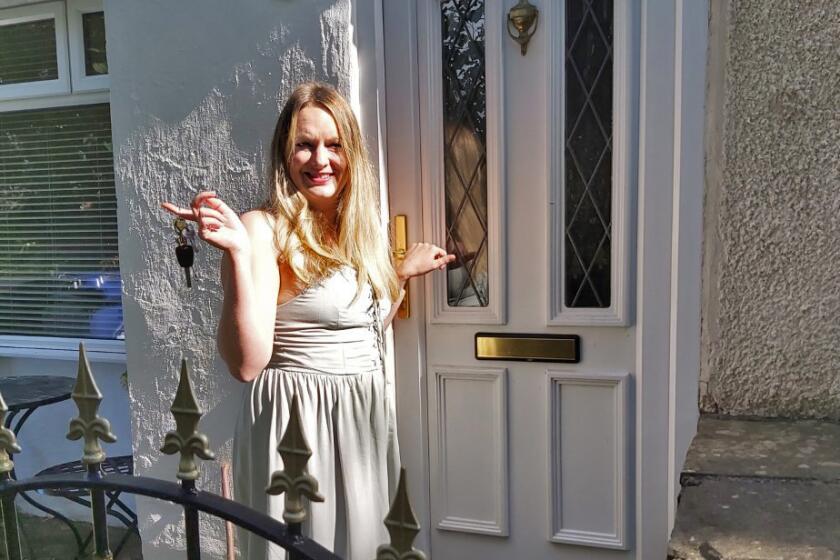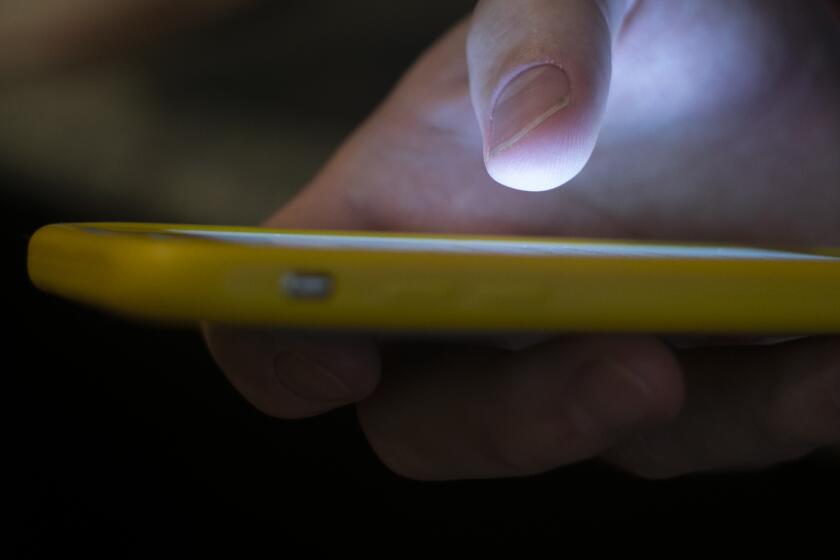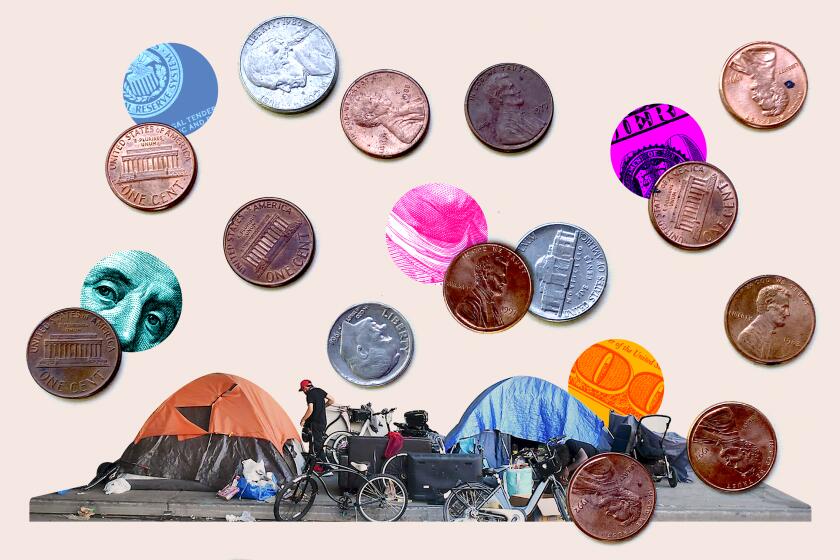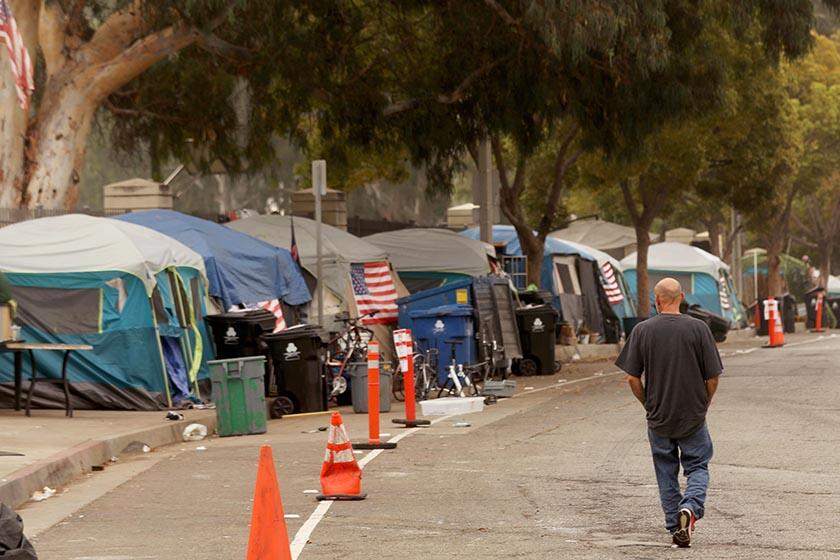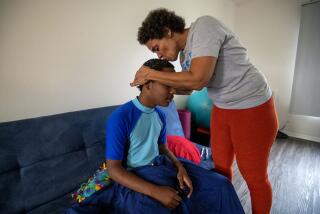The mental health system failed our son, but we hold on to hope

- Share via
We haven’t seen our son in 66 days, and counting.
Hopefully by the time you read this, we’ll have seen his face — probably too skinny, probably scared, hopefully not still angry — at his next mental health court hearing or with a conservatorship in hand. Until then, we hope he is safe as he can be on the seventh floor of high-observation housing at L.A. County’s Twin Towers jail in Chinatown, there on a vandalism charge after being arrested in Walnut for breaking a bus window.
The past two months have been spent rushing to save him, whether it’s driving from one courthouse to the other to try to make sure we make his court dates, or scouring the internet and our friend circles to find an attorney to help, or begging a social worker at the county jail for more information. The last time we saw him, he was confused, demanding, paranoid, unhoused and without any direction.
But let’s back up a bit. Can you tell it’s hard for us to focus right now?
The Times is publishing a series of personal essays by people who have all taken different approaches to mental health challenges.
A deep breath. OK. We’re Edward and Bea, the parents of two adult children. Our first-born, John, has been diagnosed with schizophrenia, a treatable brain disorder (if our county and country had a functioning mental health system and benevolent laws).
For the past 23 years, we’ve prayed and fought for John to have a good independent life that we see his church and high school buddies experiencing — maybe a family, good friends, a good career (and probably a dog because he loves ours, Cody). That’s what we always imagined John having. And at first, it was an easy dream to believe in.
We were married in 1980. Two years later, our beautiful son was born in Kansas City, Missouri — on Bea’s birthday (yes, Edward’s still a little jealous). We’d moved there after Edward graduated with an MBA from the University of Wisconsin. We were excited to start a family, as we had good support from our actual and church families.
When John was 4, and his sister was 2, we moved to California. He was your typical kid — extroverted and outgoing. He played Little League baseball. He attended private Seventh-Day Adventist schools, where he made good grades and worked as a math tutor in high school.
John had this charismatic energy that attracted friends — and girls. Bea would often pick up the phone to find John talking with a girl. “And where is your mother?” Bea would ask the caller. We were really happy.
His illness started to present his senior year of high school in 1999, but it wasn’t that obvious. He was co-captain of the varsity basketball team, and loved the Lakers. He plastered his room with posters of Kobe, Shaq and coach Phil Jackson.
How To Save A Life
Pandemic stress, traumatic events and economic uncertainty have upended our world. This series aims to make the cascade of threats to your mental health a little easier to manage.
That year, Edward had opening-night tickets for them, but when Edward got home, John was nowhere to be found. Instead, Edward found a note. “Dad, I’m sorry, but I can’t go to the game with you tonight,” John wrote. “I’m feeling paranoid.”
The fact that he used “paranoid” really threw us. “My God,” we thought. “What are you smoking or drinking, John?” We had no idea the biology of his brain was changing.
Later, John missed his senior class photo, giving us an uncharacteristically vague excuse that he didn’t make it back from off-campus lunch in time. (Bea thinks this might have been when he started smoking marijuana.)
Edward remembers how, at his high school graduation, John seemed off, distant.
John was accepted into several colleges. We thought he would follow his friends to Arizona State or a Cal State school, or Oakwood University or another historically Black college. Maybe his dad’s alma mater, Hampton University. But our popular son instead chose to study business at San Jose State University, where no one else in his friend group was going. In hindsight, we think John knew something was happening with his brain, and he wanted to distance himself from everyone he knew.
His freshman year, we got a call from the school. His GPA had dropped below 2.0, which had never happened. John had been caught with marijuana in his dorm. Bea rushed to San Jose to appear before the judge and plead his case. “Let him talk,” the judge replied. “He’s got to do this.” That’s when we started thinking about how to navigate what we later learned was our codependency regarding John’s substance-abuse issues.
The judge ordered him to regularly attend AA meetings. But soon, after he was close to failing out of college, we brought him home.
That was 2001. For the next 15 years, we worked really, really hard to find “the” answer. We kept thinking — and still do — that something would work.
To help someone in psychosis, one psychologist says, it’s best to first just be there and listen.
In 2004, when Edward came home to find John had covered his bedroom window with sheets because he believed our neighbors were throwing rocks and shooting airsoft pellets at our home, we thought a 90-day stint at a reputable Orange County drug rehab facility would help. John received fine enough care there — but no doctor or therapist there mentioned mental illness might be the culprit, and it was far from our minds too.
Our family was desperate, five months later, when John was smoking marijuana again and unconcerned about his grooming and hygiene. At our family intervention, we told John he could either get sober or leave our home. He called us on it, and we felt as though we couldn’t back down. (We later learned, too late, through support groups that tough love never works for serious mental illness.)
John asked Edward to drive him to a corner in Rancho Cucamonga, where we previously lived, and drop him off.
For the next nine weeks, we got up in the morning, held hands, and took walks around our neighborhood, crying together. Full of worry, we feared John would start abusing harder drugs, like heroin or opioids. We also feared for his physical safety. At Al-Anon meetings, we worked on our own codependent behaviors and how they might be exacerbating John’s behaviors and sickness.
We finally got a call from him at a gas station. “Dad, please come pick me up,” John said. He’d been staying with a friend the whole time, but that close friend, his home boy, as they were that close, had thrown him out. That was a major red flag for us.
When Edward arrived, he looked into John’s eyes and saw death. John had lost something — his soul, his joy, his zest for life. Until now, that was the longest we’d gone without seeing him.
Some clarity came when, finally, in 2005, John was diagnosed with schizophrenia. We’d thought for years that he must be abusing hard drugs, although every drug test showed only marijuana. His paranoia finally made sense.
So we attacked the disease from that angle. John saw a psychologist for a few years to help decrease his panic attacks and learn coping skills. We took him to a neurologist to learn how to address his involuntary shaking. He received noninvasive transcranial magnetic stimulation therapy to treat his depression. And for the first half of 2009, John was in biweekly group therapy for people with substance-abuse and mental health disorders. But the son we remembered from the first 17 years of his life wasn’t returning.
That summer, we took him to an emergency room at a San Bernardino hospital, armed with our list of reasons we were there. We hoped he would be admitted to a psychiatric unit.
Quick help for suicide thoughts and other mental health emergencies will soon be as easy as 9-8-8.
In the same way that some parents keep track of their children’s accomplishments for their annual family newsletters or save mementos for scrapbooks, we’ve kept a regularly updated timeline of every crisis, and every mental health clinic, rehab, psychiatric hospital (short-term and residential) and sober living home where John has been. We meticulously record every psychiatrist and medicine, listing the ones that work and don’t, like the one that makes him almost catatonic or another that increases his liver enzymes. And when John gets 5150ed — a term referencing the California law related to involuntary hospital commitments — we quickly hand that timeline to hospital staff, praying (truly) that they’ll read it.
That day in San Bernardino, we really weren’t sure they’d admit John, based on the arguably strict criteria it takes to make it happen in California. He’d never been 5150ed. “Did he hit you? Did he try to harm himself? Then why are you all here?” we remember the workers saying.
But when a nurse tried to take John’s temperature, he revolted. It took at least five men to restrain him. He cried out, “Dad! Dad! Why are you letting them do this to me?” Bea froze and felt chills run through her body as she heard his cries for help. Edward remembers weeping as they strapped John to the gurney and took our son to the psychiatric unit. When your child has a serious mental illness, the mental health system often has cruel ways of giving you what you want.
Two weeks after that hospitalization in 2009, he had finals at a community college and passed. Despite everything he’s been through, John has repeatedly found the resilience to keep working toward a future. Through the 2000s, he attended Chaffey College, Valley Community College and Mt. San Antonio College, always trying to enroll in far too many hours. “I have to make up for lost time,” he told us.
Over the next seven years, we kept trying. John kept trying. But his schizophrenia remained ineffectively treated until 2016. That autumn, John was kicked out of a board and care home — a small facility where people with mental illnesses can live independently with 24/7 support — in West Covina. Then we got him into a residential program in Koreatown. “Maybe this time,” we told ourselves.
And it worked. John not only completed their 90-day program voluntarily but also chose to stay an extra 30 days. The program was structured, and they kept good boundaries with parents. We kindly butted out, and they focused on healing our adult son.
They required John to do chores, and he enjoyed working in the kitchen. Each day, John and the other patients would take meals out to unhoused people who’ve come for lunch. We’ve gathered that seeing these people daily made an impression. “I don’t want that to be me,” he told us.
The men in the program would tell John, “We don’t have families like your family.” Most were older than John and poured into him that he had a chance. Even after he left, John went back to check in with the counselors there.
A millionaire’s tax was helping fund new mental health programs in California. But the Great Recession changed things — and counties got desperate.
About a year later, in 2017, he graduated from Mt. San Antonio College with an associate’s degree in business administration. He soon started Invega, a monthly injectable medicine that worked beautifully.
For the record:
3:12 p.m. Dec. 7, 2022This article says that John graduated from Cal State Bakersfield, and stopped taking Invega, in 2020. The year was 2021.
In August 2019, he moved onto the Cal State Bakersfield campus and attended classes there until the COVID-19 pandemic shut everything down. He continued his classes online, and even made the dean’s list. On Dec. 16, 2020, John graduated with a bachelor’s degree in business, shaking as he walked across the stage at commencement.
This was the last time he was truly stable.
Invega comes with side effects, including involuntary shaking. We do not want to downplay how serious that was for John but also need to emphasize that it could have been because he was not consistently taking his medicines. John never shared which side effects bothered him most, but in late 2020, after months of begging Bea and his psychiatrist to stop taking it, we all agreed. He was almost 40, and we wanted to respect his wishes and his agency. And John promised us he’d take his pills.
Until this point in our story, John had never been in the carceral system. Although John had minor traffic incidents with the law, he’d never spent time in jail, outside of a few hours when he responded aggressively toward another student at a community college and was arrested but not charged in 2003.
But this year has been the worst of all our lives.

Since 1999, when John first started showing symptoms, he had only been 5150ed once, at the San Bernardino hospital, until this year when he has been involuntarily committed six times, the last time at a hospital that discharged him after only eight days of treatment and sent him to a transitional group home in mid-July.
The hospital claimed John was stable enough to leave. We got a call that same night from the group home’s manager, who told us John was being inappropriate and loud and was filthy. “I don’t know how long your son’s going to last at the home being like this,” he said, kindly allowing John to stay.
This wasn’t the first time a hospital released John within days of the police dropping him off on an involuntary commitment hold. He’s on Medi-Cal, and in a game of catch-and-release, patients like John are kept for as long as it is profitable, and then cast back out to be someone else’s problem. Is there any wonder so many people with serious mental illnesses end up homeless?
John was arrested six days later.
The only way we’ve held on to hope is our work with the National Alliance on Mental Illness and our faith. Based on what we see and hear, we don’t see what God’s plan is, but we know there is one. We believe that God’s timeline is just different than ours. And amid all this heartache, we experience things that say to us that God is in control.
Hundreds of mentally ill detainees incarcerated across California in recent years have languished in jail long after being declared incompetent to stand trial.
When John got arrested in mid-July, Edward sensed something was wrong after not hearing from John for two days. Edward called the group home and found out John hadn’t been seen for more than a day. We had no idea he’d been arrested. We see God there.
When Edward drove to the Pomona Police Department and found out John had been arrested, he raced to multiple courthouses before finding the right one and making it just in time for John’s case, where he met our son’s public defender. We see God there.
When a stranger offered to check on John at the county jail, when John’s case was moved to mental health court, when we were contacted to tell this story you’re reading now — when our fears and anxieties are high, God delivers these glimmers of hope that tell us to keep moving.
At mental health court, the judge has twice commended us for being present at John’s hearings because so few parents come. Both times John has been too unstable to enter the court.
In jail he refuses to take his medicine and is getting sicker by the day. The court has ordered him to be medicated against his will, but forced medication can generally only be administered in the inpatient unit at Twin Towers county jail. It has a few dozen beds that hundreds of inmates, including John, are waiting for. What treatment does John get in the interim? How is this legally allowed? How is this humane?
In L.A. County, CARE Court will be implemented next year. Here’s how you can access it.
Research has shown that after a crisis, it takes a person about a year to fully recover. How will John recover from seven months of this unmedicated crisis? Can he? We hope he can at least get back to where he was before he stopped taking the Invega. Is that a false hope? We have to hold on, regardless.
Despite the thousands of dollars we’ve spent — and taxpayers have spent — on him, John has lost any chance at a predictable future. His friends have all moved on and have careers and children. John turns 40 in November, and we pray that birthday isn’t spent in the county jail. We pray we have seen him by then, and that the conservatorship (that we never wanted) is in place. We really miss our son.
More to Read
Sign up for Essential California
The most important California stories and recommendations in your inbox every morning.
You may occasionally receive promotional content from the Los Angeles Times.


